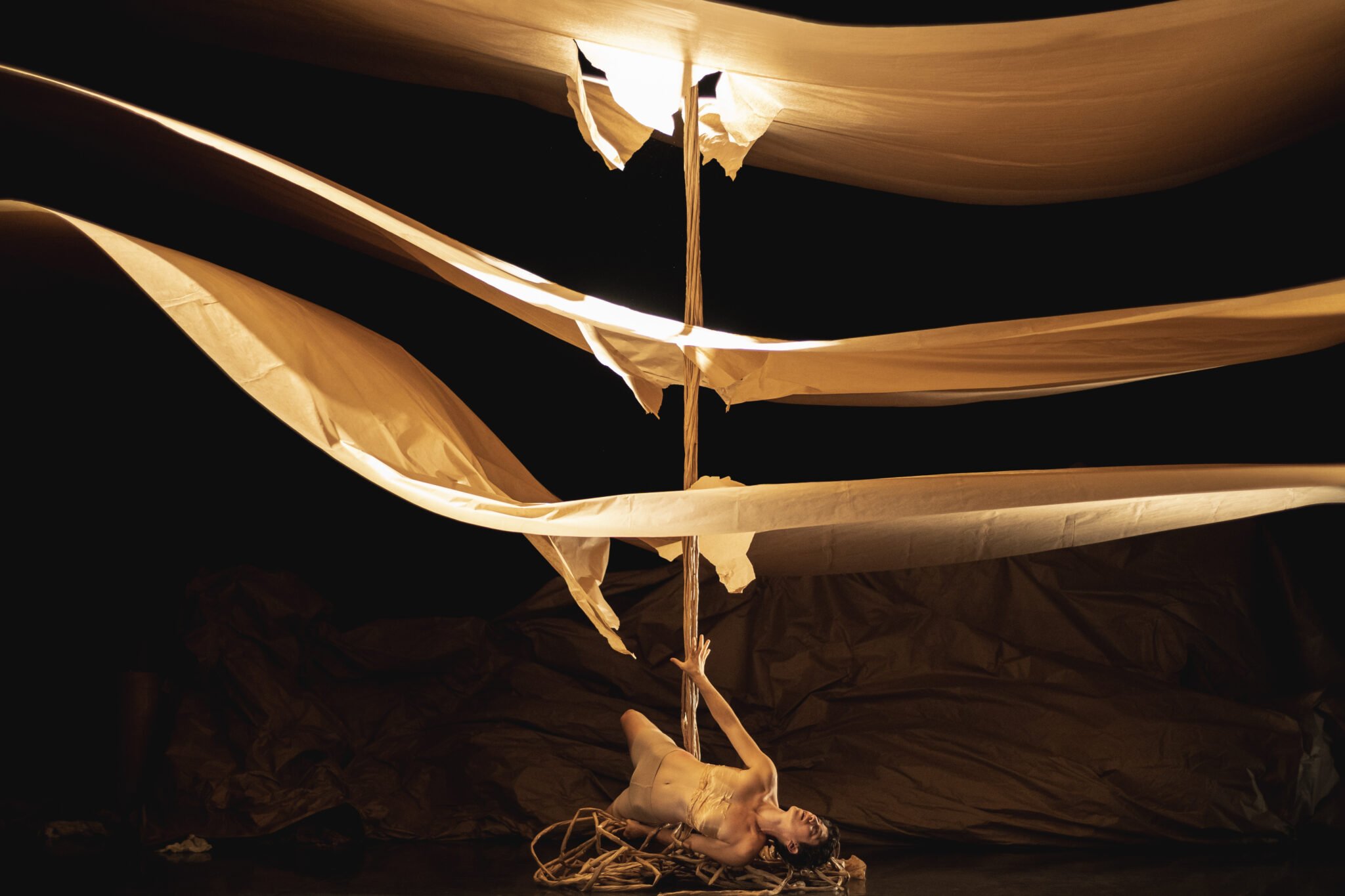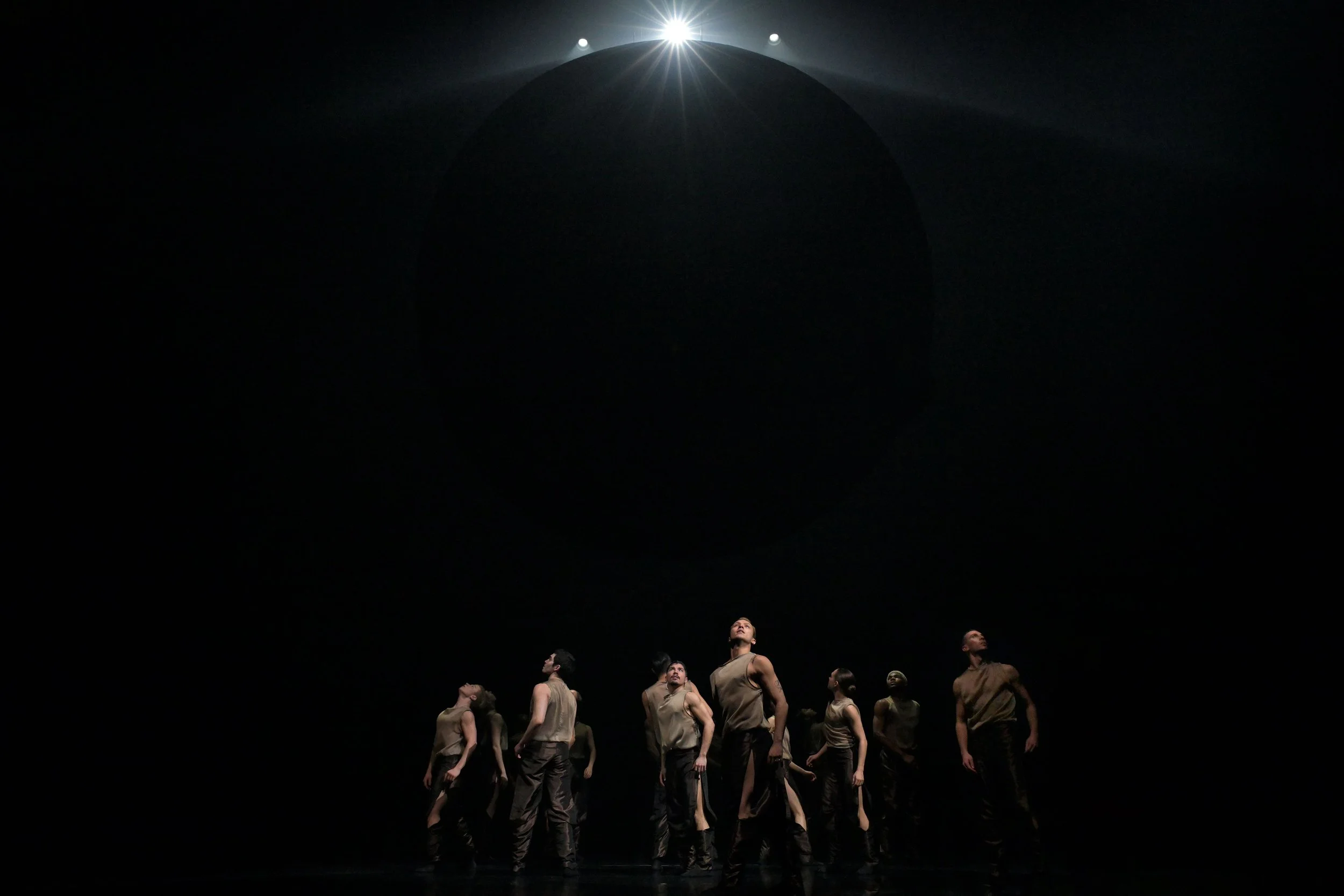Paper becomes a playground in Pli, at the PuSh Festival
The copresentation with Chutzpah! Festival sees paper used as an aerial rope, a dance partner, and more
Pli. Photo by Loïc Nys
PuSh Festival and Chutzpah! Festival present Les SUBS' Pli on February 2 and 3 at the Vancouver Playhouse and from February 2 to 4 online
EVEN IN THE digital age—or perhaps especially so—there’s nothing like paper, whether you write shopping lists on a scrap of it, pen loving words to friends and family in cards, read it to catch up on news on the daily, pore over a beloved book, or use a classic DayTimer to organize your schedule. Paper becomes much more than a place for the printed word in Pli, a circus-dance work by Les SUBS that will have its Canadian premiere at the 2024 PuSh Festival in a copresentation with Chutzpah! Festival.
In Pli, paper morphs into a playground, a dance partner, an aerial rope, a costume, and an ever-shifting sculpture. The set is made entirely of the stuff, with performer Inbal Ben Haim dancing with, on, and around it. Twisted, crumpled, and torn into various forms, paper supports the artist one minute and is ripped to shreds the next. It is constantly transforming.
Created with sculptor-visual artist Domitille Martin and paper artist-engineer Alexis Mérat, Pli—which takes its name from the French word for to fold—has transformation as its theme. The piece is as philosophical as it is physical.
Paper is an object that most people take for granted, says Ben Haim in a Zoom interview from France, where she lives.
“Paper is something that we all know,” Ben Haim says. “Everybody is in contact with paper in everyday life, from money to newspapers to notebooks to toilet paper to notes in supermarkets to books to so many things. Everyone has their own very ordinary but very intimate connection with this material, as we know how easy it is to crumple it and destroy it, and how fragile it is.”
And yet it can be extraordinarily strong and durable, as Ben Haim discovered while working with Mérat. He did mechanical tests on paper as part of the creative process, when she began climbing thick, long strands of plain brown sheets attached to the rafters as if they were pieces of sturdy rope.
“Everybody knows it’s fragile, then they see someone climbing and suspending from paper, and what is shocking is the fact it could break at any moment, it’s so fragile and delicate,” Ben Haim says. “The act of taking something so fragile, and to see that with some work it can become very resistant, is very symbolic for me. We’re all fragile in our world; we’re all human beings. But we can have some catastrophe or small virus that changes our life so much. Sometimes we forget we’re so fragile or that life is so fragile, but in a way this fragility becomes very strong and powerful and very resistant. The paper is a metaphor for that: you see something that is fragile and suddenly it becomes so powerful. Things that are very strong can also be fragile.”
The fact that Ben Haim climbs a long twisted sheet of paper is something that some people refuse to believe. She and her collaborators—in Vancouver she’ll be joined onstage by Martin and fellow visual artist Alvaro Valdes—applied to be part of an arts fest, and organizers said it was physically impossible to climb up paper; they assumed that the team had inserted metal into the material beforehand. That’s when they decided to build the aerial “rope” as part of the show. The work opens with so many rolls of paper on the ground, the artists tearing off huge sheets to use in different ways.
“What was very interesting for me was when we dived into the research, we discovered that paper is such an amazing material because it can have so much metamorphosis,” Ben Haim says. “When we shake it in the air it looks like waves; when we put it with wind it looks like sand; when we put it on the floor it looks like soil. One thing becomes another. There are so many different landscapes that appear.”
Ben Haim grew up in an artistically inclined family; her mom, a visual artist, had a studio at home. Born in Jerusalem in 1990, Ben Haim was raised in the Israeli countryside. She was going to pursue visual arts but discovered circus in 2004 at Free Dome Project, then the Shabazi Circus. She was hooked. She specialized in the static trapeze and aerial rope. In 2011 she left her homeland to pursue circus in France, going on to train at Centre Régional des Arts du Cirque PACA – Piste d’Azur then at the Centre National des Arts du Cirque in Châlons-en-Champagne. She has created a language all her own by blending circus with dance, theatre, improvisation, and visual arts.
“I was falling in love with it when I was 14,” Ben Haim says of circus arts. “I was a hyperactive girl; I had to do sports all the time—dance and martial arts and athletics. I had this charge of activity that my body needed to do. When I discovered circus, I was also climbing on everything. My parents said when I was one year old they discovered me on the upper part of a ladder and they freaked out. I was learning how to climb before I was learning how to walk. Climbing is something I always loved and felt good with, and when I discovered aerial circus, something just calmed down in my body.
“It’s very intensive physically but it takes concentration,” she adds. “The physical feeling was amazing for me and really made me change the way I was feeling my body moving. I wanted to be in the air on the rope and trapeze all the time. It’s physical but very poetic. I think circus deals with realism and surrealism a lot. Something in this articulation was touching me deeply in a way that was very concrete: you need to really work hard to suspend yourself from your hands in the air and at the same time it is such a poetic thing.”
The use of paper in Pli combines Ben Haim’s love of technical, visual, and poetic elements.
“The need for all three of us to be onstage is to mix the gestural language of the circus and the gestural language of building something, creating something in an artistic way out of the material,” Ben Haim says. “There are no tricks; we build the set in front of people’s eyes. It’s not just an acrobatic show. It’s a language of metamorphosis between circus and performing arts and fine arts on-stage. We can do so many things with paper that I never imagined.”














